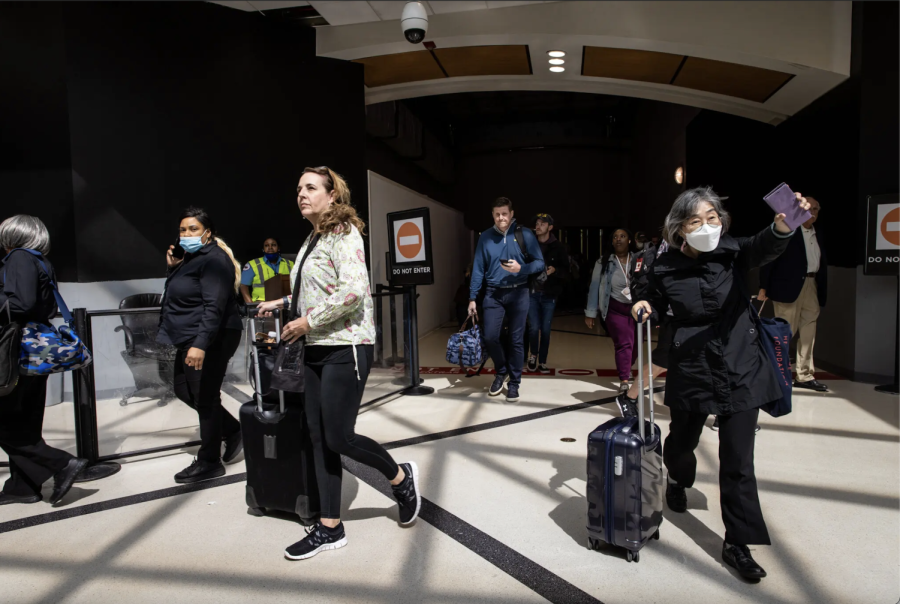Changing Mask Mandates Force COVID Reality Check
Photo Courtesy of The New York Times
Some travellers chose to remove their masks in Atlanta’s Hartsfield-Jackson International Airport after the public transport mask mandate was lifted.
You’re probably looking at this and thinking, “Another COVID article? Can’t we talk about something else?” To be honest, I was hesitant to write this article because it can be exhausting to talk about COVID all the time, but recent events have convinced me otherwise. In spite of the brief excitement about the prospect of dropping masks, seeing videos of people midflight enthusiastically reacting to mask mandates on airlines being removed and the recent wave of COVID cases at Oberlin have served as reality checks.
Obviously, Oberlin is in a bubble isolated from the rest of the country. 95 percent of the campus is vaccinated and boosted, cases have been mild among students, and we still have a mask mandate. But we very recently had a glimpse of what the majority of the country is experiencing when ObieSafe announced that it was removing mask mandates and not requiring testing upon return from spring break. In the days following this announcement, I heard an interesting combination of reactions. There was initially a sense of happiness and relief that we would be joining the rest of the country in lifting our mask mandate; just weeks afterward, though, I heard fear and anxiety from people that they would be the next person to catch COVID from a party or from a significant other. These events have made me ask again, “What will normalcy look like when the pandemic ends?”
If anything, normalcy is hard to think about right now. Mask mandates have become complicated and contradictory, as Zoey Birdsong explained in an Opinions piece last week. Saying, “I want to stay safe from COVID-19,” has somehow become a political statement. According to The New York Times, as of today, we’re less than 5,000 COVID deaths away from one million mostly preventable fatalities in the United States.
There’s no good answer for what normalcy looks like. Whenever I try to think about it, I always picture who I would’ve become if the pandemic never happened. To me, normal can look like small things– — a future where I don’t have to see a COVID tab tracking vaccines and deaths on Google, where I don’t have to think about whether I should pull my mask down when I’m outside, where I can make up for missed birthdays and funerals. I’m sure the normalcy we all envision is a future without masks and COVID testing, and it’s hard to recognize that we’re probably not going to have a maskless 2022 or even 2023. But I’m realizing that pretending everything is normal — when it really isn’t — does a great disservice to the victims of this pandemic.
I think about the story and life of John Brennan, the first resident in my home state of New Jersey to die from COVID, and how I don’t know anything about the 33,474 other stories that have emerged since. I think about the college student who lost her grandmother, father, and mother to COVID. I still feel heartbroken and angry every time I see another video on social media of an elderly Asian American getting beaten up because I know that as long as the pandemic exists, anti-Asian hate crimes will continue to manifest in physical assaults on the most vulnerable people.
They, along with millions of Americans with similar stories, are being left behind when the mask mandates are removed, when we pretend that we are going back to normal, and when we say that COVID is just like a mild case of the common cold. It shouldn’t take mass death or suffering for people to realize that we need to look out for each other as a community.
I’m not immunocompromised and I don’t live with anyone who is unvaccinated, elderly, or otherwise at greater risk. I’m very grateful to be one of the approximately 40 percent of Americans who did not test positive for COVID at all through this pandemic. But that doesn’t mean I shouldn’t care about the people who cannot say the same and who feel disregarded through this phase of forced normalcy. Nothing about COVID and the collective reaction to it is normal. Let’s accept that instead of ignoring it.







